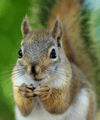Study sheds new light on deadly squirrel pox virus

(PhysOrg.com) -- Bird tables which bring red and grey squirrels into close contact could be contributing to the spread of the squirrel pox virus by creating a 'hotspot' for the disease.
Research led by Newcastle University has revealed seasonal peaks in the transmission of the pox virus - a disease which is largely responsible for the dramatic decline in the UK’s red squirrel population.
These ‘high risk’ peaks were found to correlate to times of the year when both species of squirrel roamed further afield - either because of a shortage of food or while searching for a mate - increasing the chance for disease transmission.
Published in the July issue of Epidemiology and Infection, the research highlights the risk of creating ‘hotspots’ which attract both red and grey squirrels to the same place, such as bird tables and other feeding stations.
Dr Peter Lurz, one of the authors of the research based at Newcastle University, explained: “In areas where grey squirrels test positive for the antibody to the virus, the rate of decline of red squirrels has been up to 25 times higher than elsewhere.
“It’s a terrible disease with a very high death rate among reds but how it is transmitted from grey to red squirrels is still not clear.
“What this clearly shows is that creating points where the two species of squirrel are likely to meet is actually putting our reds at greater risk of infection.”
Introduced in the 19th century, the North American grey squirrel has spread across the UK while native red squirrel numbers have plummeted.
Red squirrels not only have to compete for resources with the invader but are also affected by a lethal disease, caused by squirrel pox virus, which is carried by grey squirrels.
The virus has no apparent effect on grey squirrels but is invariably fatal to reds and is strongly associated with the red’s dramatic decline.
Despite the devastating effect it has had on the red squirrel, little is known about the epidemiology of the virus and how it is spread.
Studying the squirrels in Northumberland and the Scottish Borders, the team mapped out seasonal variation of prevalence patterns for the viral antibody and found infection rates were particularly high during spring and at a low in autumn. They also found the spread of infection was strongly male-biased.
This correlated to times of the year when squirrels move further afield either because of a shortage of food or while searching for a mate.
The findings suggest a direct disease transmission route, including through environmental contamination, from grey to red squirrels.
Feeding stations such as bird tables in gardens, known to be attractive to both species, could therefore contribute to disease spread by creating a ‘hotspot’ where the two squirrels and the virus come into contact.
Dr Lurz said the findings added another important piece to the puzzle of transmission and suggested ways in which red squirrel management could reduce disease incidence.
“Current approaches to red squirrel management and conservation often include feeding stations and monitoring systems using baited tubes or hoppers but these techniques should be re-evaluated to minimise contact between the two squirrel species,” he said.
“Encouraging them to your garden and feeding squirrels in areas where both red and grey squirrels occur - while it may be done with the best of intentions - could actually do far more harm than good.”
More information: Epidemiology of squirrelpox virus in grey squirrels in the UK, Epidemiology and Infection (2010), 138:941-950. doi:10.1017/S0950268810000816
Provided by Newcastle University
















